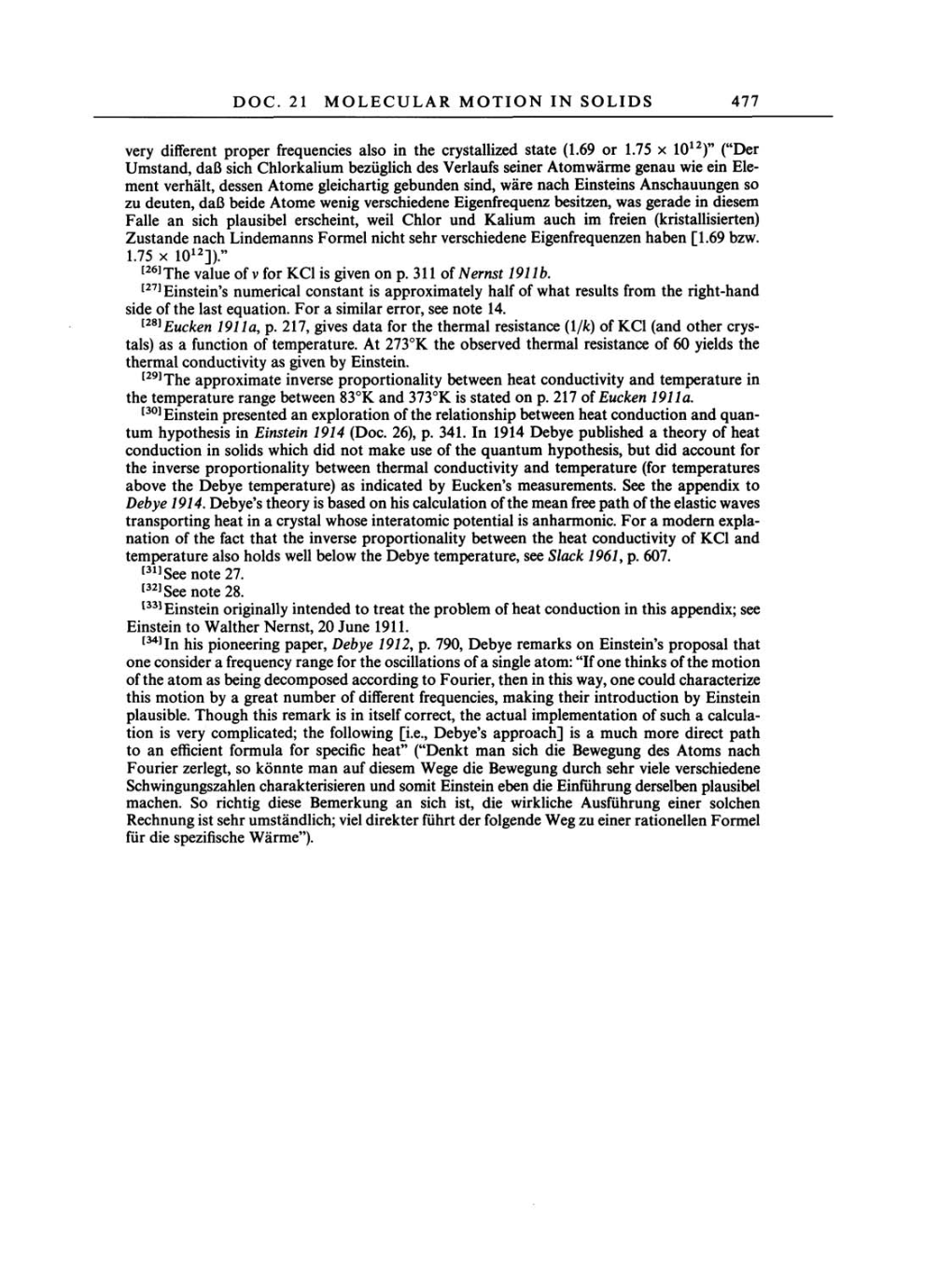DOC.
21
MOLECULAR
MOTION
IN
SOLIDS
477
very
different
proper frequencies
also in the
crystallized
state
(1.69 or
1.75
x 1012)"
("Der
Umstand,
daß
sich
Chlorkalium
bezüglich
des Verlaufs seiner
Atomwärme
genau
wie ein Ele-
ment verhält,
dessen Atome
gleichartig gebunden sind,
wäre nach
Einsteins
Anschauungen so
zu
deuten,
daß beide Atome
wenig
verschiedene
Eigenfrequenz
besitzen,
was
gerade
in
diesem
Falle
an
sich
plausibel
erscheint,
weil
Chlor und Kalium auch
im freien
(kristallisierten)
Zustande nach Lindemanns Formel nicht sehr verschiedene
Eigenfrequenzen
haben
[1.69
bzw.
1.75
x
1012])."
[26]The
value of
v
for KCl
is
given on
p.
311
of Nernst
1911b.
[27]Einstein's
numerical
constant is
approximately
half of what results from the
right-hand
side
of
the
last
equation.
For
a
similar
error,
see
note
14.
[28]Eucken
1911a,
p.
217, gives
data for the thermal resistance
(1/k)
of KCl
(and
other
crys-
tals) as a
function of
temperature.
At 273°K
the observed thermal resistance of
60
yields
the
thermal
conductivity as
given by
Einstein.
[29]The
approximate
inverse
proportionality
between heat
conductivity
and
temperature
in
the
temperature range
between 83°K and
373°K is
stated
on
p.
217
of
Eucken 1911a.
[30]Einstein
presented an exploration
of
the
relationship
between heat conduction and
quan-
tum
hypothesis
in
Einstein
1914 (Doc.
26), p.
341.
In
1914 Debye
published
a
theory
of heat
conduction
in
solids which did
not
make
use
of the
quantum hypothesis,
but did
account
for
the inverse
proportionality
between thermal
conductivity
and
temperature (for temperatures
above the
Debye temperature) as
indicated
by
Eucken's
measurements. See
the
appendix
to
Debye
1914.
Debye's
theory is
based
on
his
calculation of
the
mean
free
path
of
the
elastic
waves
transporting
heat
in
a
crystal
whose interatomic
potential
is
anharmonic.
For
a
modern
expla-
nation of the fact
that
the inverse
proportionality
between the heat
conductivity
of KCl and
temperature
also holds
well
below the
Debye
temperature, see
Slack
1961, p.
607.
[31]See note 27.
[32]See
note 28.
[33]Einstein
originally
intended
to treat
the
problem
of heat conduction
in
this
appendix; see
Einstein
to
Walther
Nernst, 20
June
1911.
[34]In
his
pioneering paper,
Debye
1912,
p.
790, Debye
remarks
on
Einstein's
proposal
that
one
consider
a
frequency
range
for the oscillations of
a
single
atom:
"If
one
thinks of
the
motion
of
the atom
as being decomposed according
to Fourier,
then
in
this
way,
one
could characterize
this motion
by
a great
number of
different
frequencies, making
their introduction
by
Einstein
plausible. Though
this remark
is in
itself
correct,
the actual
implementation
of
such
a
calcula-
tion
is
very complicated;
the
following
[i.e.,
Debye's approach]
is
a
much
more
direct
path
to
an
efficient
formula for
specific
heat"
("Denkt man
sich die
Bewegung
des Atoms nach
Fourier
zerlegt,
so
könnte
man
auf
diesem
Wege
die
Bewegung
durch sehr
viele
verschiedene
Schwingungszahlen
charakterisieren und somit Einstein eben die
Einführung
derselben
plausibel
machen.
So richtig diese Bemerkung
an
sich
ist,
die wirkliche
Ausführung
einer solchen
Rechnung ist
sehr
umständlich; viel
direkter führt der
folgende Weg
zu
einer rationellen Formel
für
die
spezifische
Wärme").
